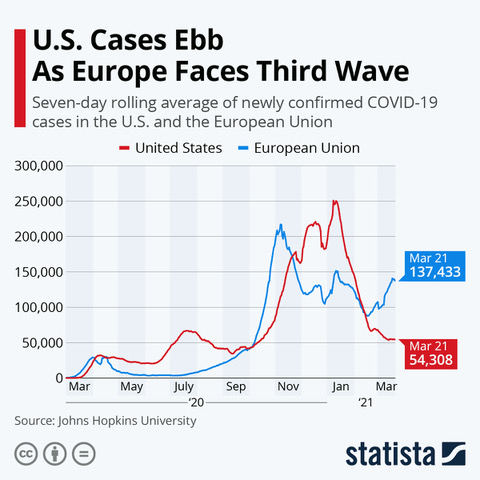SINGAPORE, 26 March 2021: The Covid-19 pandemic is stretching into its second year with no signs of letting up any time soon, but travel and hospitality companies across Southeast Asia are demanding borders reopen quickly to give the tourism industry a chance of survival.
Where will the travel bookings come from once airlines start flying to Southeast Asia destinations? Will the industry have to wait for Asian travellers to return and China to open the gate for outbound tours to resume? Or should they look west for inoculated travellers from the US and Europe?

Statista data presents insights on the way forward and argues there is a growing “transatlantic divide in public mood between the UK and Europe. US travellers might be in the mood to bounce back before Europeans recognise they are safe and ready to go.
If we have to rely on vaccinated travellers from long haul markets like the US and Europe, then reopening borders this side of October might be a futile exercise.
Here’s the Statista perspective
“There’s a growing transatlantic divide in the public mood. While the finish line appears to be in sight for the US, where a rapid vaccine rollout and falling case numbers have sparked a wave of optimism, large parts of Europe are facing another type of wave – the third wave of Covid-19 infections,” according to Statista’s latest blog.
“As the chart shows, the seven-day average of new infections in the US has fallen to the lowest level since mid-October in recent weeks, after peaking at levels five times as high as recently as mid-January.
“Meanwhile, many European countries are seeing the opposite trend, as new variants of SARS-CoV-2, most importantly the more infectious B.117 variant, have led to a reversal in infection activity, which is now rising again despite large parts of the continent still being on at least partial lockdown. It appears that the measures that helped contain the spread of the original virus aren’t sufficient to keep the new variants in check, while public pressure to reopen schools, childcare facilities and businesses are making it even harder for politicians to make what many experts consider the right call: tightening restrictions instead of loosening up.
“What makes matters worse is the fact that the vaccine rollout across the European Union is going much slower than many had hoped. As of 21 March, the EU’s 27 member states have administered 13 doses per 100 people, while the US stands at 37 doses per 100 inhabitants. So while Americans have reason to believe that the worst will be over by summer this year, the mood across the Atlantic is considerably gloomier as a fatigued public is facing a third wave of infections coupled with sluggish vaccination progress.”
(Blog: Felix Richter Data Journalist Statista).
This chart shows the seven-day rolling average of newly confirmed Covid-19 cases in the US and the European Union.
VISIT: https://www.statista.com/chart/22102/daily-covid-19-cases-in-the-us-and-the-eu/






